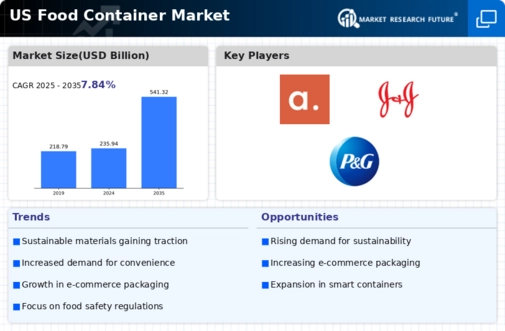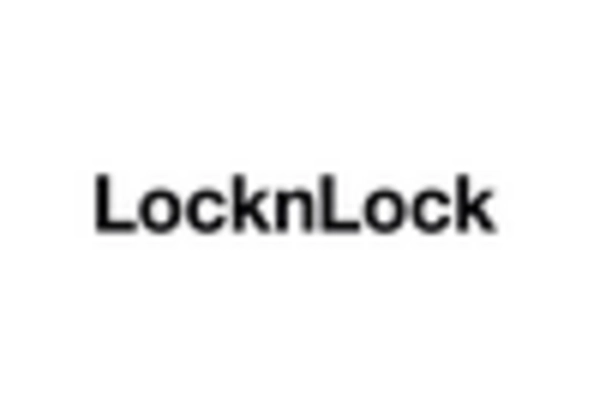The food container market exhibits a dynamic competitive landscape characterized by innovation, sustainability, and strategic partnerships. Key players such as Tupperware Brands Corporation (US), Rubbermaid Commercial Products LLC (US), and Thermos LLC (US) are actively shaping the market through diverse strategies. Tupperware Brands Corporation (US) focuses on enhancing its product line with eco-friendly materials, aiming to capture the growing consumer demand for sustainable options. Meanwhile, Rubbermaid Commercial Products LLC (US) emphasizes operational efficiency and supply chain optimization, which positions it favorably in the commercial sector. Thermos LLC (US) leverages its strong brand heritage to innovate in thermal technology, appealing to health-conscious consumers seeking reliable food storage solutions. Collectively, these strategies foster a competitive environment that prioritizes sustainability and innovation, driving market growth.
The market structure appears moderately fragmented, with numerous players vying for market share. Key business tactics include localizing manufacturing to reduce costs and enhance responsiveness to regional demands. This approach not only optimizes supply chains but also allows companies to tailor products to local preferences, thereby increasing customer satisfaction. The collective influence of major players, while significant, is balanced by the presence of smaller, niche companies that cater to specific consumer needs, further enriching the competitive landscape.
In October 2025, Tupperware Brands Corporation (US) announced a partnership with a leading sustainable materials supplier to develop a new line of biodegradable food containers. This strategic move underscores Tupperware's commitment to sustainability and positions the company to meet the increasing consumer demand for environmentally friendly products. By integrating sustainable practices into its core offerings, Tupperware aims to differentiate itself in a crowded market, potentially enhancing brand loyalty among eco-conscious consumers.
In September 2025, Rubbermaid Commercial Products LLC (US) launched an advanced line of food storage solutions designed specifically for the food service industry. This initiative reflects the company's focus on innovation and operational efficiency, catering to the unique needs of commercial clients. By providing tailored solutions that enhance food safety and storage efficiency, Rubbermaid strengthens its market position and addresses the growing demand for high-quality food storage in professional settings.
In August 2025, Thermos LLC (US) introduced a new smart food container equipped with temperature control technology and a mobile app for monitoring food freshness. This innovation not only enhances user convenience but also aligns with the increasing trend towards digitalization in consumer products. By integrating technology into its offerings, Thermos positions itself at the forefront of the market, appealing to tech-savvy consumers who prioritize functionality and convenience in their food storage solutions.
As of November 2025, current trends in the food container market indicate a strong shift towards digitalization, sustainability, and the integration of artificial intelligence in product development. Strategic alliances among key players are increasingly shaping the competitive landscape, fostering innovation and enhancing product offerings. The evolution of competitive differentiation appears to be moving away from price-based competition towards a focus on technological advancements, sustainability, and supply chain reliability. This shift suggests that companies that prioritize innovation and adapt to changing consumer preferences will likely emerge as leaders in the market.

















Leave a Comment